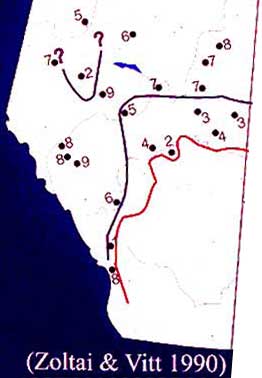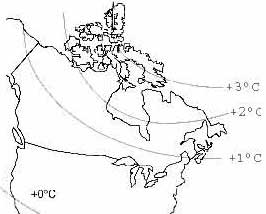 Alberta's WaterIntroductionPublications Climate Change Industrial Impacts Agricultural Impacts Urban Impacts Biodiversity Loss Definitions Links Site Map |
 |

A Few Impacts of Climate Change
|
|
About 6,000 years ago, Lake Manitoba was dry. Temperatures at that time were cooler than what is expected in the near future. |
 |
 |
|
as compared to today. |
The Age of Praire Wetlands, in Thousands of Years |
There have been times during the Holocene Period, from 10,000 years ago until today, when the earth was warmer than it is today. The maximum was about 6,000 years ago. This map above shows how much warmer North America was, and it must be noted that these differences are smaller than those we can expect from climate change over the next 50 years.
Lake Manitoba, the 12th largest lake in North America based on surface area, is shallow and particularly susceptible to drying. This lake was actually dry during the mid Holocene, when the estimated average temperature was only 1° C warmer than in the mid 20th century.
There were few, if any, wetlands in the southern prairies in the dry mid Holocene. The map to the right shows ages of wetlands estimated from 14C (radiocarbon) dating of the deepest peat deposits in existing wetlands. Each dot represents a wetland, with its approximate age in thousands of years indicated by a digit. The northernmost line represents the approximate southern boundary of wetlands greater than 6000 years old. The southernmost line represents the approximate southern limit of contemporary wetlands.


